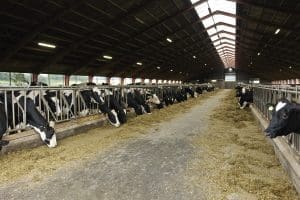
By Burt Rutherford Contributing Editor
It began as a mystery disease in dairy cattle and has become, as of this writing, an emerging animal health issue that expands almost daily. It is Highly Pathogenic Avian Influenza virus that crossed the species barrier from wild birds to lactating dairy cows and ultimately was officially designated at HPAI in cattle. And it’s a big deal that is getting bigger.
Because of the fast moving, liquid nature of the disease, it’s very likely the situation will be different by the time you read this. Stay alert and stay informed. In the meantime, here’s a synopsis of what we know as of early May.
First, the good news. So far, HPAI in cattle has only been detected in lactating dairy cattle. It has not been detected in feedyard beef cattle, pasture cattle or young calves.
It’s unknown why the virus only affects lactating dairy cattle, according to Tera Barnhardt, DVM, a consulting feedyard and dairy veterinarian with Heritage Vet Partners. “I wish we had an answer,” she said. “But we’re working long, hard hours and we will get to the bottom of it. We have to. We have a lot of brothers and sisters in poultry production who are linking arms with us on this and working toward a solution.”
According to the U.S. Department of Agriculture’s (USDA’s) Animal and Plant Health Inspection Service (APHIS), the virus has not been detected in ground beef and, when properly prepared, it is safe to eat. “The U.S. Food and Drug Administration and USDA believe that our commercial milk supply is safe because of both the pasteurization process and the required diversion or destruction of milk from sick cows. Pasteurization has continuously proven to inactivate bacteria and viruses in milk,” according to a USDA news release.
“It’s a great time for producers and feedyards to connect with their veterinarian and develop plans and protocols that support practical and effective biosecurity efforts.”
– Tera Barnhardt, DVM
To that end, Dr. Barnhardt has no qualms about her young family. “My family goes through 4 gallons of whole milk a week and it is too numerous to count the pounds of beef, and I am proud to set it on our dinner table.”
While the futures market reacted negatively immediately following the USDA announcement of HPAI virus infection in dairy cattle, no other market disruptions have occurred. Internationally, beef exports remain generally unaffected, with Colombia the only country that imports U.S. beef announcing a ban.
Here are the actions APHIS has instituted:
Mandatory Testing for Interstate Movement of Dairy Cattle
- Prior to interstate movement, dairy cattle are required to receive a negative test for Influenza A virus at an approved National Animal Health Laboratory Network (NAHLN) laboratory.
- Owners of herds in which dairy cattle test positive for interstate movement will be required to provide epidemiological information, including animal movement tracing.
- Dairy cattle moving interstate must adhere to conditions specified by APHIS.
- As will be described in forthcoming guidance, these steps will be immediately required for lactating dairy cattle, while these requirements for other classes of dairy cattle will be based on scientific factors concerning the virus and its evolving risk profile.
Mandatory Reporting
- Laboratories and state veterinarians must report positive Influenza A nucleic acid detection diagnostic results (e.g. PCR or genetic sequencing) in livestock to USDA APHIS. Laboratories and state veterinarians must report positive Influenza A serology diagnostic results in livestock to USDA APHIS.
- USDA has identified spread between cows within the same herd, spread from cows to poultry, spread between dairies associated with cattle movements, and cows without clinical signs that have tested positive. The novel movement of H5N1 between wild birds and dairy cows requires further testing and time to develop a critical understanding to support any future courses of action.
“While we are taking this action today, it is important to remember that thus far, we have not found changes to the virus that would make it more transmissible to humans and between people. While cases among humans in direct contact with infected animals are possible, our partners at the U.S. Centers for Disease Control and Prevention (CDC) believe that the current risk to the public remains low,” USDA said in a news release.
“Additionally, we continue to see affected cows recover after supported care with little to no associated mortality. We also continue to work with our partners in the states and industry to emphasize the critical importance biosecurity plays in limiting disease spread for all livestock and poultry.”
“It’s a great time for producers and feedyards to connect with their veterinarian and develop plans and protocols that support practical and effective biosecurity efforts,” Dr. Barnhardt said.
But she cautions that producers shouldn’t miss the forest for the trees. “We have to continue to do our work with animals the same way we did before we knew HPAI in cattle was a possibility. Our farms have a lot of moving parts to manage every day. We can’t forget these parts while simultaneously maintaining a deep respect for the larger impacts of this evolving situation.”
To learn more about USDA’s response to HPAI in dairy cattle, visit www.aphis.usda.gov/livestock-poultry-disease/avian/avian-influenza/hpai-detections/livestock.





